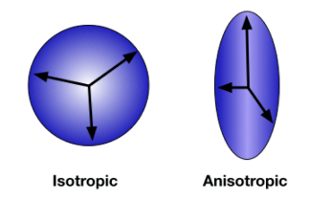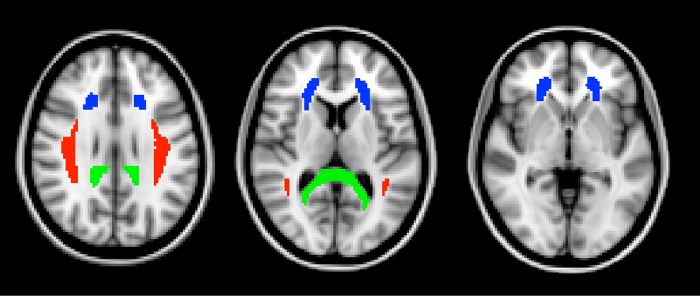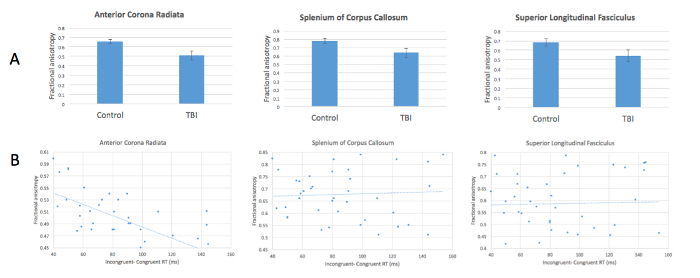외상성 뇌 손상에서의 확산 텐서 이미징 사용
English
소셜에 공유하기
개요
출처: 조나스 T. 카플란과 사라 I. 짐벨의 연구소 – 서던 캘리포니아 대학
MRI를 사용하는 전통적인 뇌 이미징 기술은 뇌의 총 구조를 시각화하는 데 매우 능숙합니다. MRI로 만든 구조적 뇌 이미지는 회색과 흰색 물질 사이의 테두리의 높은 대비를 제공하고 뇌 구조의 크기와 모양에 대한 정보를 제공합니다. 그러나, 이러한 이미지는 뇌의 백색 물질 네트워크의 기본 구조와 무결성을 자세히 설명하지 않습니다, 이는 로컬 및 먼 뇌 영역을 상호 연결하는 축축산 번들로 구성.
확산 MRI는 물 분자의 확산에 민감한 펄스 서열을 사용합니다. 확산 방향을 측정함으로써 뇌의 백색 물질 네트워크의 구조에 대한 추론을 할 수 있습니다. 축 사 내의 물 분자는 세포막에 의한 그들의 운동에 제약을 받습니다; 동일한 확률 (동위 학적 운동)을 가진 모든 방향으로 무작위로 이동하는 대신, 그들은 축삭 (위축성 운동)과 병행하여 특정 방향으로 움직일 가능성이 더 높습니다. 그림 1). 따라서 확산 성산의 측정은 섬유 밀도, 축삭 두께 및 골수의 정도와 같은 백색 물질의 특성을 반영하기 위해 생각된다. 한 가지 일반적인 측정은 분수 이방성 (FA)입니다. FA 값은 완전히 동위 위축 운동을 나타내는 0에서 최대 이소성 효과를 반영하는 1까지 다양합니다.

그림 1: 확산 성위축. 확산의 방향이 제한되지 않고 임의로 발생하면 움직임은 모든 방향으로 동등하게 측정됩니다. 이것은 등위 위력 확산 (A)입니다. 물 분자가 뉴런의 축삭 내에 포함될 때, 확산은 축삭(B)의 방향을 따라 더 자주 발생하는 경향이 있는 이영양성이다. 이 그림의 더 큰 버전을 보려면 여기를 클릭하십시오.
이 실험에서 우리는 외상성 뇌 손상 (TBI)에서 백색 물질 무결성을 측정하기 위해 확산 텐서 이미징 (DTI)을 사용합니다. TBI는 외부 힘이 머리에 타격이나 자동차 사고로 발생할 수있는 종류와 같은 갑작스런 움직임과 같은 뇌를 손상시킬 때 발생합니다. 기계적 힘에서 뇌 손상의이 유형은 뇌 전체에 백색 물질에 확산 축 상 손상과 관련. 백색 물질 무결성에 영향을 미치는 부상이기 때문에 표준 신경 이미징 기술은 손상을 밝히지 않을 수 있습니다. 그러나 확산의 측정은 이러한 해부학적 변화에 특히 민감하다. 크라우스 외에의해 연구 다음 . 1,우리는 건강한 통제의 그룹을 TBI를 가진 사람들의 단에 비교하고 뇌백색 물질에 TBI의 효력을 측정하기 위하여 확산 화상 진찰을 이용합니다. 또한 주의과제를 사용하여 백색 물질 무결성과 인지 기능 의 관계를 테스트할 것입니다. 2 이 연구는 코퍼스 캘로섬의 스플레늄, 전방 코로나 라디에아, 및 우수한 세로 근막(도 2)의세 가지 백색 물질 영역에 초점을 맞춘 관심 영역 (ROI) 접근 방식을 사용합니다.

그림 2: 관심 영역입니다. ICBM DTI-81 아틀라스에서 정의된 3개의 ROI는 뇌를 통과하는 수평 슬라이스로 여기에 표시됩니다. 녹색은 코퍼스 캘로섬의 스프렌디움입니다. 스프렌륨은 코퍼스 캘로섬의 가장 후방 부분입니다. 파란색은 전방 코로나 라디아입니다. 우수한 세로 근막은 빨간색으로 표시됩니다. 이 그림의 더 큰 버전을 보려면 여기를 클릭하십시오.
Procedure
Results
The FA values from the three ROIs are shown in Figure 3. Fractional anisotropy was significantly lower in the TBI group in all three ROIs, indicating the presence of widespread white matter damage in those individuals. This non-localized loss of white matter integrity is typical of TBI.

Figure 3: Reduced anisotropy in patients with TBI and relationship with attentional control. (A) FA values are significantly lower in TBI patients compared with healthy controls in all 3 ROIs. (B) FA in the anterior corona radiata correlates negatively with increased incongruency effect in the attention task. Please click here to view a larger version of this figure.
Our measure of attentional control-response time differences between congruent and incongruent targets-correlated negatively with FA values in the anterior corona radiata (Figure 3). In other words, greater differences in response time, indicating poorer attentional control, are associated with decreased FA. These results evidence a relationship between white matter integrity in this location and performance on this task. This relationship was not found in the other two ROIs. The anterior corona radiata is associated with connections to the anterior cingulate cortex, a structure known to play an important part in attentional control.
Applications and Summary
Because diffusion imaging can reveal differences in white matter structure that are often not visible with traditional MRI imaging, it is an important tool for understanding brain structure and function. In this experiment we identified a clinically relevant marker for traumatic brain injury that may be used to predict the behavioral consequences of such an injury. DTI has been especially useful in the study of brain development, as changes in white matter structure are found throughout the lifespan from early childhood through late adulthood. For example, aging in older adults is associated with a decline in fractional anisotropy.
More sophisticated analysis of diffusion images allows for the reconstruction and tracing of fiber tracts in the brain, a process known as tractography. Tractography uses the directional information in contiguous voxels to trace specific fiber bundles as they traverse through the brain and can help to build models of the various interconnections among brain structures. This technique can be used to study the connections between individual brain regions of interest, or alternatively to analyze the entire connectome, or complex network structure, of the brain.
References
- Kraus, M.F., et al. White matter integrity and cognition in chronic traumatic brain injury: a diffusion tensor imaging study. Brain. 130, 2508-2519 (2007).
- Niogi, S.N., et al. Structural dissociation of attentional control and memory in adults with and without mild traumatic brain injury. Brain. 131, 3209-3221 (2008).
- Fan, J., McCandliss, B.D., Sommer, T., Raz, A., & Posner, M.I. Testing the efficiency and independence of attentional networks. J Cogn Neurosci. 14, 340-347 (2002).
내레이션 대본
Diffusion Tensor Imaging—DTI—is a technique within magnetic resonance that relies on the diffusion of water molecules to study the integrity of white matter networks—the axon bundles that connect cortical and subcortical gray matter—in the brain.
These interconnecting structures can be damaged when an external force, such as a soccer ball, comes into contact with the head during a match. Such repetitive interactions can lead to more severe injury, referred to as Traumatic Brain Injury, TBI for short.
Over time, the damage to cerebral white matter is often associated with deficits in cognition, particularly in the attentional domain. For instance, a player with TBI might be more distracted by a fan in the stands and slower to react to the opposing team.
Based on previous work performed by Kraus and colleagues, this video demonstrates how to measure white matter integrity using DTI in patients with TBI compared to healthy control individuals.
We will also examine cognitive function using a selective attention task, explain how to analyze the imaging data, and interpret the relationship between diffusion values in defined regions of interest and attentional control.
In this experiment, two groups of participants—patients diagnosed with moderate to severe TBI and control individuals that are healthy—are scanned using a DTI protocol, and then tested on an attention task.
First, let’s discuss a few principles behind DTI: The technique is sensitive to the diffusion of water molecules, which are always moving, mostly in parallel to the vast amount of axonal bundles. This type of movement is known as anisotropic diffusion.
Along with the path of water flow, the amount of diffusion can be measured to compute the tensor—essentially illustrated as an ellipsoid with a direction. This value is quantified based on the relative length to its width using a method called fractional anisotropy, abbreviated as FA.
More specifically, FA values can range from 0—isotropic, or equal movement—to 1, which reflects the greatest amount of anisotropy.
The precision is maximized across all voxels by acquiring diffusion images during an MRI scan in many different directions that correspond to shifts in the applied magnetic field. This increased resolution occurs at the expense of time.
Knowing that, a critical dependent variable consists of the FA values for three regions of interest, or ROIs: the anterior corona radiata, the splenium of the corpus callosum, and the superior longitudinal fasciculus.
Compared to normal controls, the FA values are expected to be reduced in individuals with TBI, as their white matter is expected to be compromised in a non-localized manner, resulting in less anisotropy across all ROIs.
However, one region—the anterior corona radiata—is associated with connections to the anterior cingulate cortex, which plays an important role in attentional control.
To further explore this functional relationship between white matter integrity and behavior, all participants are tested on the Attention Network Task developed by Fan and colleagues.
In this paradigm, participants are asked to focus their attention, first towards a fixation cross that appears for a variable duration between 400 and 1600 ms, followed by two different types of arrows: a central one and two flanking groups that may vary in the direction they point.
In half of the trials, all of the arrows point in the same direction; these are considered to be congruent. For the other half, the center arrow points the opposite way of the flanking ones, and these cases are referred to as incongruent. Participants are asked to categorize the arrows by making associated keypresses as quickly as possible when each new set appears.
Here, the difference in reaction times between trial types is calculated as another dependent variable. Individuals who are more distracted by the flanking arrows are expected to have a larger difference score, which indicates poor attentional control.
This measure is therefore predicted to negatively correlate with the FA values, specifically in the region related to attentional ability—the anterior corona radiata—and not the others, thus showing functional significance of particular white matter tracts.
Prior to the experiment, recruit 20 adult patients that have been diagnosed with moderate to severe TBI within the last 6 months and age-matched controls, who have no history of neurological or psychological disorders.
For the purpose of this demonstration, test a patient that’s documented as having a loss of consciousness for more than 30 min or a score of < 13 on the Glasgow Coma Scale.
On the day of their scan, greet them and ensure that they do not suffer from claustrophobia or have any metal in their body; also have them fill out the necessary consent forms detailing the risks and benefits of the study.
After gaining consent, prepare the patient to enter into the scanning room. For more detailed information on the pre-scan procedures, please refer to another MRI project in this collection.
With the patient now in the scanner bore, first collect a high-resolution anatomical scan. Then, initiate a pulse sequence optimized for DTI by acquiring a B0 image—one that is not sensitive to diffusion direction—as well as multiple diffusion-weighted images in 64 different directions.
When the sequence is complete, escort the patient out of the scanner and into an experimental room with a computer to perform the next phase, an Attention Network Task.
Explain the task instructions: They will see a series of five arrows on the screen and should focus only on the center one. To ensure quick and accurate responses, have them place their hands on the keyboard, with their left index finger on the ‘F’ key and right one on ‘J’.
During trials where the center arrow is pointing left, instruct them to press ‘F’. Otherwise, when it is facing right, press ‘J’.
Allow the patient to complete 100 trials: Remember that each starts with a fixation cross that remains on the screen for a variable duration of 400 to 1600 ms, after which arrows appear, and the central one will either be incongruent or congruent.
Notice that the arrows remain on the screen until the patient responds, or for a maximum of 1700 ms if they don’t press either key. Also note that every trial ends with a fixation cross that remains visible for a total trial duration of 4 s.
At the end of the attention task, debrief the patient to conclude the study, and compensate them for their participation.
After the scanner and behavioral data have been obtained, the raw diffusion files first need to be converted into tensor images.
To begin preprocessing, perform distortion correction for eddy currents, which commonly occur in the raw data as a result of changing the magnetic field during acquisition.
To compensate for motion, apply a linear rigid-body affine transformation, which registers each of the directional diffusion images to the B0 reference.
In addition, isolate the brain from the skull and other non-neural tissues to ensure that tensors are not calculated for voxels outside of the brain.
Now, combine all 64 directional images to calculate the diffusion tensor at each voxel, and output the corresponding FA values in the background.
Subsequently, register the diffusion images to the high-resolution anatomical scan, and then to a standard atlas space to allow for group-level analysis.
With pre-processing completed, use a white matter atlas to identify three ROIs: the anterior corona radiata, the splenium of the corpus callosum, and the superior longitudinal fasciculus.
Finally, register each participant’s anatomical image to the standard atlas, and use these to warp the ROI masks into each participant’s brain space.
To graph the data, compare the extracted FA values by group, plotting each ROI separately. Notice that FA values were significantly lower in the TBI group in all three ROIs, indicating widespread white matter damage in those patients.
To incorporate the behavioral data, plot the differences in reaction times between incongruent and congruent trials against the FA values for all subjects. Perform a Pearson correlation analysis on these overall results, again independently for each ROI.
This time, only one of the regions—the anterior corona radiata—showed a significant correlation, in the negative direction. That is, high FA values were associated with fast reaction times, whereas low anisotropy corresponded to longer response times. These findings suggest a functional link between connecting white matter and attentional control.
Now that you are familiar with how to relate structure and function using DTI and an attentional control task, let’s look at how researchers are using similar approaches to study other populations with compromised connectivity or as a way to protect it.
While normal aging is associated with cognitive decline, changes aren’t necessarily widespread. Rather, they appear to be related to specific functions that correspond to white matter integrity and reduced FA values, especially in the prefrontal cortex. Thus, diffusion imaging could be used as a method for the early detection of age-related changes in executive function.
Using data collected by DTI, researchers can use a 3D technique called fiber tractography and reconstruct white matter tracts throughout the entire brain. This modeling procedure is useful across many domains, including neurosurgery.
If, for instance, surgeons need to remove a tumor, they can plan exactly where the white matter tracts are in proximity to critical structures and avoid detrimental consequences.
You’ve just watched JoVE’s introduction to diffusion tensor imaging. Now you should have a good understanding of how to design and conduct a DTI experiment, as well as how to analyze and interpret specific diffusion patterns with cognitive implications related to traumatic brain injury.
Thanks for watching!
